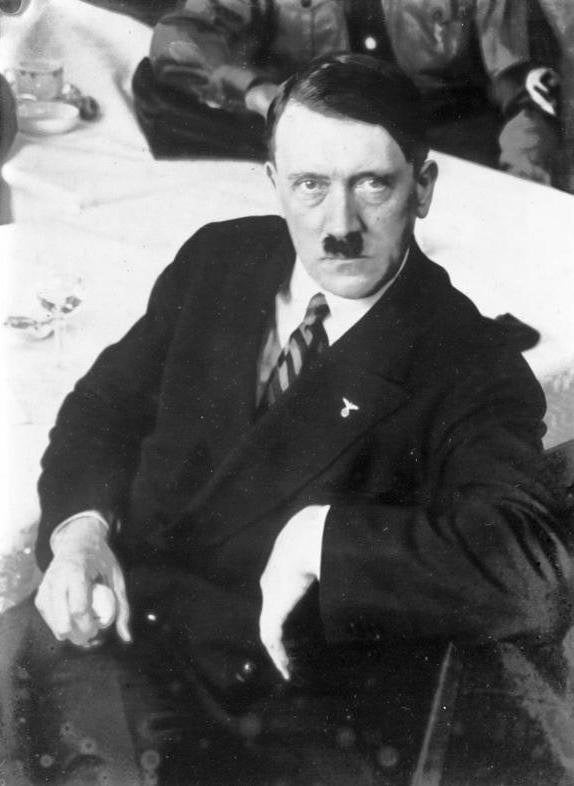
Excerpted from THE MISSING INK: THE LOST ART OF HANDWRITING by Philip Hensher, published in November 2012 by Faber and Faber, Inc., an affiliate of Farrar, Straus and Giroux. Copyright © 2012 by Philip Hensher. All rights reserved.
Hitler seems to have disliked writing by hand altogether.
One of the reasons why it has been possible for extremist 'historians' to make the odious case that he actually knew nothing of the Final Solution was that, in his twelve years as Chancellor, he 'very rarely committed his thoughts on important issues to paper in formal memoranda.'
That is true even of typed documents. He himself stopped writing anything by hand long before his death. One of the last surviving examples of his handwriting comes in a private testament of 2 May 1938 - the subsequent testament, drawn up just before his suicide in 1945, is typewritten.
Subsequently, he grew worried about the legal basis of this testament, believing that, as an unnotarized will, it had by law to be written entirely by hand, not including the printed headings on his notepaper - this seems not to have been the case.
Hitler had the handwriting that you might expect of someone of his limited educational background. His short encounter with the educational establishment included the Realschule in Linz where, for at least one year, his presence overlapped with that of the philosopher Wittgenstein, then at an early stage in his schooling. (Wittgenstein and Hitler were the same age, but as Wittgenstein was advanced a year and Hitler held back, they were two classes apart, and no one knows if they ever really encountered each other.) Interestingly,
Wittgenstein's poor written German led to him failing one exam - the Linz Realschule evidently didn't do a good job in encouraging its alumni to write. What we see in Hitler's handwriting of 1938 is a script that must have seemed old-fashioned to some parts of the German-speaking world even at the time of his schooling, forty years before, and by 1938 was certainly passing out of use. For instance, he indicates a double m in kommt by a line over the single m, in the black-letter style. After 1938, he apparently gave up writing at all by hand.
As we have seen, that didn't stop him from taking an interest in handwriting, and in 1941 decreeing that the established Sütterlin Fraktur hand should be abandoned in German schools in favour of a more modern Latin script. The main interest of Hitler's handwriting, however, is what happened to it after he died.
Because of the abandonment of Sütterlin in 1941, and the confirmation of that decision after the war by the authorities of East and West Germany, by the 1970s only trained specialists could read historic Fraktur scripts. By the 1970s, too, there was an enormous market in fake Nazi documents, including forged signatures and even letters purporting to be by Hitler. The trade was encouraged not only by the fascination and horror of the subject, but also by the fact that it was harder to detect a forgery where not many people could read what was being written.
Around 1980, some diaries, supposedly written by Hitler, started to surface. They were the most abject forgeries, which anybody ought to have been able to see through from the start. The story of how Stern magazine and its star reporter, Gerd Heidemann, were fooled by a small-time con man called Konrad Kujau, and how in turn Heidemann defrauded his employer of millions of Deutschmarks before allowing the UK Sunday Times to make a perfect ass of itself has been brilliantly told by Robert Harris in his classic Selling Hitler. What interests us here is the light cast on the analysis of handwriting by the behavior of several 'experts' in the field of forensic analysis.
The handwriting of Hitler is a favorite topic of many graphologists, who enjoy pointing out the features in his hand which indicate his megalomaniacal psychopathy. Some graphologists indicate particular graphic features in his writing - for instance the slant of his writing - which indicate his specific politics or even his genocidal tendencies. Given the faint eccentricity of graphologists when in character-analysis mode, perhaps some caution ought to have been exerted when asking them to put on their forensic-analysis hat.
There were a number of problems that arose when considering the authenticity of the 'Hitler Diaries'. First, hardly anybody in the Stern building apart from the crook
Heidemann could read the script - this was forty years after the abandonment of Fraktur in German schools. Second, the handwriting experts who examined the script were either not up to the job, working within a fatally flawed discipline, or given misleading evidence to work on.
A Doctor Max Frei-Sulzer, a former head of the forensic department of the Zurich police, was 'provided with two photocopies of documents from the Stern hoard: the Hess statement and a draft telegram to the Hungarian ruler, Admiral Horthy.'
As comparison material, Frei-Sulzer was supplied with . . . copies of authentic Hitler writing . . . a third set of documents for comparison was provided by Gerd Heidemann
from his private collection . . . Unfortunately for Frei-Sulzer, these supposedly genuine examples of the Fuhrer's writings were also the work of Konrad Kujau, a confusion which meant that the scientist in some instances would be comparing Kujau's hand with Kujau's.
Another expert, Ordway Hilton, an American forensic examiner, was also roped in, although he could not even understand German, let alone the difficult hand. When his report came in, it stated that 'The lack of lower loop, the flattened single-space letters, the variable use of letterforms and the interruptions in the words especially at points when the letterforms are connected in other instances are all common to both the known and this page of writing under investigation. The combination of all these factors establishes in my opinion adequate proof that this document was written by the same person who prepared all the known writings . . . I must conclude that [Hitler] prepared the document.'
Hilton was completely wrong, as was Frei-Sulzer, who declared that 'there can be no doubt that both these documents were written by Adolf Hitler'. Only at the very end of the disastrous story was any doubt voiced, when a further handwriting analyst, Kenneth Rendell, carried out a much more systematic analysis of the material, and concluded that 'the capital letters E, H and K in the 1932 volume had striking dissimilarities to the same letters in authentic examples of Hitler's writing.'
Hitler was one of the first people to decide to give up writing by hand. His handwriting, however, had some more life in it. The frightful saga of authentication over the forged diaries suggests that analysis of handwriting on a forensic basis is a much less accurate science than its proponents claim. Most of the graphologists employed by Stern couldn't reliably tell the difference between a blatant forgery and the real thing, not even suggesting that there might be room for doubt here.
When we come to the much stranger 'science' of character analysis through graphology, we might like to remember the failure to identify Hitler's handwriting. If a professional analyst couldn't tell the difference between a letter written by Hitler and one written by a cheap forger, is it at all likely that he will be able to diagnose Hitler's political tendencies or character defects through the direction in which the letters lean?
Related on HuffPost:
